Speak directly to the analyst to clarify any post sales queries you may have.
The food ingredients sterilization market is accelerating as manufacturers prioritize safety, quality, and regulatory compliance. Senior leaders are navigating an evolving technology landscape that demands both operational excellence and strategic foresight.
Market Snapshot: Food Ingredients Sterilization Market Overview
The food ingredients sterilization market grew from USD 464.36 million in 2024 to USD 493.99 million in 2025. It is expected to continue growing at a CAGR of 6.30%, reaching USD 757.21 million by 2032. Heightened consumer demands for safe, high-quality foods and more stringent global regulatory oversight are influencing adoption of next-generation sterilization solutions. Driven by escalating production volumes and rising supply chain complexity, industry participants are investing in innovations that optimize performance, reduce contamination risk, and align with sustainability goals.
Scope & Segmentation
Comprehensive Segmentation Enables Strategic Decision-Making
- Technique: Chemical (chlorine dioxide, ethylene oxide), filtration (microfiltration, nanofiltration, ultrafiltration), irradiation (electron beam, gamma ray, X ray), and thermal (dry heat, wet heat).
- Ingredient Type: Colors & flavors, cultures, dairy products, fibers, oils & fats, proteins & enzymes, spices & seasonings, vitamins & minerals.
- Equipment Type: Autoclave, gas plasma system, high pressure system, membrane filter (microfiltration, nanofiltration, ultrafiltration units), tunnel pasteurizer (HTST tunnel, UHT tunnel), UHT system (direct, indirect), UV system.
- Process: Batch and continuous operations.
- End User: Food processing businesses and research laboratories.
- Region: Americas (North America: United States, Canada, Mexico; Latin America: Brazil, Argentina, Chile, Colombia, Peru), Europe, Middle East & Africa (Europe: United Kingdom, Germany, France, Russia, Italy, Spain, Netherlands, Sweden, Poland, Switzerland; Middle East: United Arab Emirates, Saudi Arabia, Qatar, Turkey, Israel; Africa: South Africa, Nigeria, Egypt, Kenya), Asia-Pacific (China, India, Japan, Australia, South Korea, Indonesia, Thailand, Malaysia, Singapore, Taiwan).
- Key Companies: Sotera Health Company, Ion Beam Applications S.A., Ionisos International S.A.S., STERIS Corporation, Fedegari Group S.p.A., Getinge AB, GEA Group Aktiengesellschaft, JBT Corporation, SPX FLOW, Inc., Avure Technologies, Inc.
Key Takeaways for Senior Decision-Makers
- Innovative sterilization technologies, including advanced irradiation and membrane-based filtration, are redefining efficiency and reducing energy consumption in food processing operations.
- Continuous changes in global and local regulations demand agile compliance strategies, with a strong emphasis on sustainability and reduced chemical sterilant reliance.
- Strategic collaborations are accelerating solution deployment, as market leaders forge alliances with equipment vendors, research bodies, and ingredient suppliers for tailored process development.
- Regional variations influence the adoption of technology and compliance protocols, with manufacturers adapting supply chain approaches to address trade volatility and regulatory heterogeneity.
- Segmentation by technique, ingredient type, and end user supports targeted investments and aligns capabilities with specific processing needs and product categories.
- Data-driven digital monitoring is enabling predictive maintenance, ensuring operational continuity, and creating opportunities for continuous improvement in system performance.
Tariff Impact: Navigating 2025 U.S. Trade Measures
Recent U.S. tariff changes have prompted food ingredient sterilization companies to revisit procurement and sourcing. Companies are shifting to more domestic suppliers to mitigate exposure to international trade volatility, which is influencing equipment investment and distribution strategies. Rising logistics and component costs are impacting supply chain resilience, with organizations consolidating operational footprints and embedding tariff clauses in contracts to maintain margin stability and supply continuity.
Methodology & Data Sources
This market intelligence report is built on a multi-source approach, including primary research from executive interviews and focus groups with leading manufacturers and regulatory experts. Extensive secondary research reviewed white papers, peer-reviewed journals, and government publications to ensure comprehensive trend identification and strategic clarity. Data triangulation and scenario modeling enhance the accuracy and reliability of findings.
The Value of Food Ingredient Sterilization Market Analysis
- Empowers leaders to identify growth opportunities across technique, equipment, and region, supporting informed capital allocation and risk mitigation.
- Enables proactive responses to shifting regulatory standards and technological advances, safeguarding quality assurance and compliance processes.
- Facilitates benchmarking against industry innovators and peer organizations, providing strategic guidance for partnership development and supply chain adaptation.
Conclusion
The food ingredient sterilization market is evolving rapidly as innovation, compliance, and operational agility become critical. Stakeholders equipped with robust market insights will be positioned to successfully navigate challenges and capitalize on sustainable growth opportunities.
Additional Product Information:
- Purchase of this report includes 1 year online access with quarterly updates.
- This report can be updated on request. Please contact our Customer Experience team using the Ask a Question widget on our website.
Table of Contents
3. Executive Summary
4. Market Overview
7. Cumulative Impact of Artificial Intelligence 2025
Companies Mentioned
The companies profiled in this Food Ingredients Sterilization market report include:- Sotera Health Company
- Ion Beam Applications S.A.
- Ionisos International S.A.S.
- STERIS Corporation
- Fedegari Group S.p.A.
- Getinge AB
- GEA Group Aktiengesellschaft
- JBT Corporation
- SPX FLOW, Inc.
- Avure Technologies, Inc.
Table Information
| Report Attribute | Details |
|---|---|
| No. of Pages | 183 |
| Published | October 2025 |
| Forecast Period | 2025 - 2032 |
| Estimated Market Value ( USD | $ 493.99 Million |
| Forecasted Market Value ( USD | $ 757.21 Million |
| Compound Annual Growth Rate | 6.3% |
| Regions Covered | Global |
| No. of Companies Mentioned | 11 |









